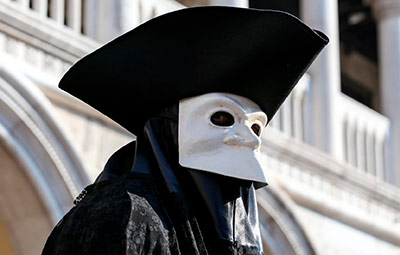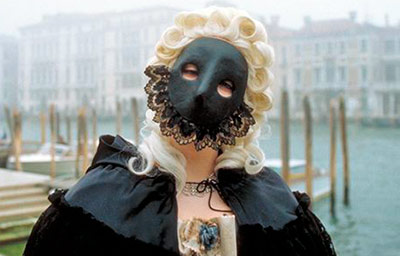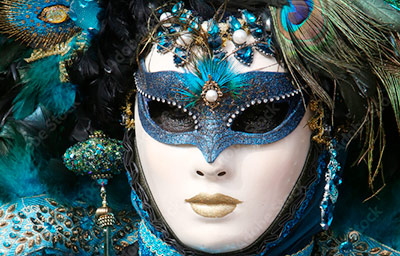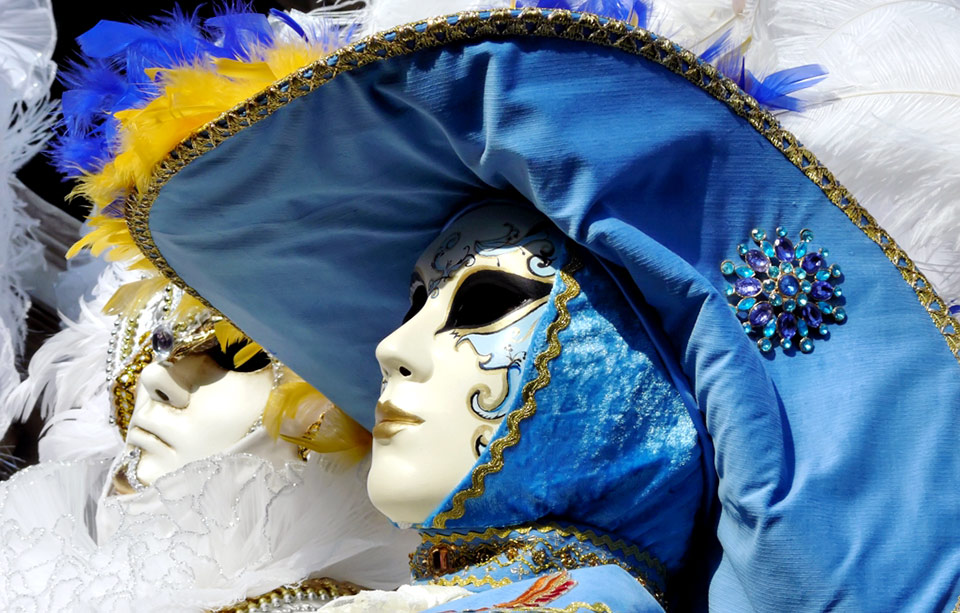The Carnival of Venice is an annual festival. Carnival starts around two weeks before Ash Wednesday and ends on Shrove Tuesday (Fat Tuesday or Mardi Gras), the day before Ash Wednesday. You can rent costumes and masks and take part in its famous festival.
In the month of February the Venice Carnival returns!
At the Venice Carnival the city becomes an open-air theater where creativity and free expression stand out. In the month of February, music, shows and the festive atmosphere fill the streets and squares of Venice, in a Carnival that extends throughout the city. Venice invites you to participate in the most famous Carnival in the world.
Venice Carnival Events
Inaugural parade along the Grand Canal
On Saturday the inaugural parade takes place along the Grand Canal in which all the symbols of the Carnival tradition are put on stage, dresses, decorations, colors, games of lights and music gathered in a great floating spectacle that parades along the Grand Canal.
Courtship of Venetian boats
The following Sunday is the turn of the traditional parade of typical lagoon boats, in collaboration with the rowing associations of Voga alla Veneta. An exceptional procession of masked boats travels along the Grand Canal, starting from Punta della Dogana and arriving at the Rialto Bridge.
Mask contest
In St. Mark's Square in Venice and in Piazza Ferretto in Mestre, two theaters are set up to accommodate all the masks that want to participate in the now traditional Competition of the Most Beautiful Mask. Photos of the masks are posted and voted on online, declaring a winner at the end of each day and then the overall winner at the end of the entire Carnival. In addition to the photographic decoration, music, scenic events, artists, declaimers and magicians also alternate on the stages.
Night show at the Arsenal
The Arsenal is the protagonist of an extraordinary and exciting show on the water. It is a show of strong visual and artistic impact, of imaginative visions, lights, technique and sensitivity, which offers an experience of pure magic.
Presentation of the 12 Marys of the Venice Carnival
The following Saturday is the presentation to the public of the 12 Marys of Carnival. These beautiful women parade dressed in historical costumes aboard gondolas along the Grand Canal until they reach St. Mark's Square, where they are received and presented to the public. The Marías participate in an intense program of events and sociocultural activities that ends with the announcement of the winners of the contest: the María of the Year and the María of Il Gazzettino, a local newspaper. The following Tuesday the traditional presentation of the victorious Mary takes place in St. Mark's Square.
Parades of allegorical floats
Parades of masked floats throughout the city, from the lagoon islands (Lido, Pellestrina and Burano) to the mainland.
The Carnival of Culture
Art and theater celebrate Carnival with a program of shows in the city's cultural spaces.
Dinner Show and Official Carnival Dance
The official Carnival Dinner Show and Dance at Ca' Vendramin Calergi, between sumptuous dresses and unforgettable artistic shows, the "sinners" will gather in the magnificent rooms overlooking the Grand Canal.
Carnival of Venice Program
- Carnival opening show. Saturday, 9:00 p.m. Show in the square with famous artists, to open the Carnival under the sign of entertainment and culture.
- The traditional flight of the Angel. Sunday at 12:00 p.m.
- The Festa delle Marie. On Sunday at 3pm from San Pietro di Castello.
- Historical reenactments on two consecutive Sundays.
- Drag Queen Beauty Contest. Following Friday in St. Mark's Square. A European level competition.
- Most Beautiful Mask Contest. From Thursday to Sunday. 3:00 p.m., with an international jury.
- The Commedia dell’Arte. From Thursday to Sunday in St. Mark's Square.
- Shrove Tuesday in St. Mark's Square. Last Tuesday. Celebration with music in the square to end the Carnival.
History
Though it probably had much earlier roots, the Carnevale di Venezia was supposedly first recorded in 1296, when the Senate of the Republic issued an edict declaring the day before Lent as a public holiday. Much as in other cities, Medieval and Renaissance Venetians appear to have celebrated Carnival in several guises. On the one hand, it was an official festival, for the most part staged in Piazza San Marco, the Piazzetta, in the courtyard of the Ducal Palace, or out in the Bacino of San Marco (the basin adjoining the port). These events, especially during and after the sixteenth century, celebrated the founding and governing myths of the state: its tranquility, durability, prosperity, fairness, and piety. Some of these official festivities were violent (oxen and pigs were let loose in the Palace courtyard and then slaughtered) but they still conveyed the overarching theme of civic unity. On the other hand, a good deal of popular energy during Carnival was directed into group rivalries, between parishes or between large geographic factions that divided the city. These could be extremely violent at times, involving bull fights, the running of oxen or pigs down the streets, or mass brawls with sticks or fists, often on bridges.
By the seventeenth century the Carnival of Venice had become a regular attraction for tourists from Northern Europe, especially the so-called Grand Tourists: young aristocratic men who spent a year or more visiting the cultural attractions of Italy. Between 1600 to 1840 these visitors wrote literally hundreds of accounts of their visits to Italy, and many had something to say about the Carnival of Venice. It was claimed by some seventeenth-century guidebooks that upwards of 30,000 visitors would come to the city during the week before Ash Wednesday, along with around 10,000 prostitutes. Reading between the lines of what they wrote, it would seem that Grand Tourists came to the Carnival of Venice to (in ascending order of interest) dress in costume, see the opera, gamble in the state-licensed ridotti, and frequent the prostitutes.
A case could be made that for most of the last two hundred years of the Venetian Republic, as the city’s hospitality infrastructure continually expanded, Carnival had become fundamentally a tourist event and no longer the sort of spontaneous, transgressive popular display that is associated today with places like Rio or Trinidad. When the Republic fell in 1797, Carnival was soon banned, and it remained forbidden throughout the Austrian occupation (1815-66). With reunification, however, an attempt was made to bring Carnival back, it had lost much of its original participatory character, with the festivities attracting more spectators than celebrants. Much of the problem may have been the lack of tourist interest. For a few generations these officially sponsored events sputtered along, until the event was outlawed under those Fascist laws that forbade wearing a mask in public. For the next half century, the Carnival of Venice was a dress-up event for children’s parties.
The Carnival was reincarnated in early February 1979, when, some parents and civic leaders in the city decided to sponsor a more formal festival to substitute for the parties of teenagers, which many thought were getting too rowdy. This first iteration lasted only four days, and even many Venetians who were there at the time appear to have forgotten it was held that year. Most people remember instead the Carnival of next year, which some say was the only truly “Venetian” one ever held. Thanks to good weather and lots of planning, there were celebrations, miming, and music all over the city, including an enormous ball held in Piazza San Marco on Fat Tuesday—and it was a ball almost entirely composed of locals. The festive displays and encounters were also almost exclusively put on by Venetians, operating with the motto, : Ma varda che poco che basta: Look how little you need! Then the tourists began to come.
Venetian Carnival Masks
Masks have always been a central feature of the Venetian carnival; traditionally people were allowed to wear them between the festival of Santo Stefano (St. Stephen's Day, December 26) at the start of the carnival season and midnight of Shrove Tuesday. They have always been around Venice. As masks were also allowed during Ascension and from October 5 to Christmas, people could spend a large proportion of the year in disguise. Maskmakers (mascherari) enjoyed a special position in society, with their own laws and their own guild.
Venetian masks can be made in leather or with the original papier-mâché technique. The original masks were rather simple in design and decoration and often had a symbolic and practical function. Nowadays, most of them are made with the application of gesso and gold leaf and are all hand-painted using natural feathers and gems to decorate.
Bauta

Bauta is a mask which covers the whole face, with a stubborn chin line, no mouth, and lots of gilding. One may find masks sold as Bautas that cover only the upper part of the face from the forehead to the nose and upper cheeks, thereby concealing identity but enabling the wearer to talk and eat or drink easily. It tends to be the main type of mask worn during the Carnival. It was used also on many other occasions as a device for hiding the wearer's identity and social status.
It would permit the wearer to act more freely in cases where he or she wanted to interact with other members of the society outside the bounds of identity and everyday convention. It was thus useful for a variety of purposes, some of them illicit or criminal, others just personal, such as romantic encounters.
Moretta

The Moretta is an oval mask of black velvet that was usually worn by women visiting convents. The name means dark, because of its color. It was invented in France and rapidly became popular in Venice as it brought out the beauty of feminine features. The mask was finished off with a veil, and was secured in place by a small bit in the wearer's mouth. The secret for the success is its shape. Small and made with black velvet, that enhances the features of women’s faces and their light complexion, characteristic that makes it immediately very popular in Venice.
Larva

The Larva, also called the face mask, is mainly white, and typically Venetian. It is worn with a tricorn and cloak. It is thought the word larva comes from the Latin meaning "mask". Like the bauta, the shape of the mask allowed the bearer to breathe and drink easily, and so there was no need to take it off, thus preserving anonymity. These masks were made of fine wax cloth and so were much lighter and were not irritating to wear making them ideal for eating, dancing and flirting.
The Mask-Makers
The mascherari, or mask-makers had their own statute dated 10 April 1436. They belonged to the fringe of painters and were helped in their task by sign-painters who drew faces onto plaster in a range of different shapes and paying extreme attention to detail.
Costumes and dresses for the Carnival
The Venetians used masks and costumes to completely hide their identity and thus erase any trace of belonging to social class, sex or religion. Everyone could adopt attitudes and behaviors based on new customs and changes in appearance. For this reason, the greeting that was continually heard when meeting someone was simply "Good morning, lady in the mask!" The joyful and unknown participation in this collective costume ritual was, and continues to be, the very essence of Carnival. It is about spending a few days without worries, a few days of liberation from daily habits and all prejudices.
With the increasingly widespread custom of dressing up for Carnival, a true trade in masks and costumes was born in Venice. Today in Venice they make dresses for Carnival that are enriched with details such as embroidery, beads and plumage. In the city you can rent a dress accompanied by a delicate hat, a mask and refined veils to experience the Venice Carnival intensely from total anonymity and enjoy the spectacle of seeing the most imaginative and disparate costumes.



